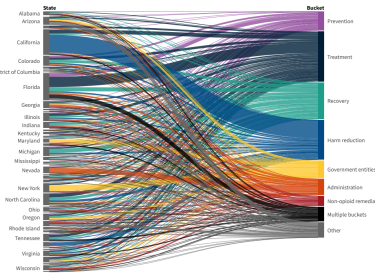
This Week's News in Substance Use: 1/4/19
In Rehab, ‘Two Warring Factions’: Abstinence Vs. Medication, The New York Times
More than 70,000 people in the United States died of overdoses in 2017, and opioids were the main driver. But nationally, 49 percent of the nearly 3,000 residential programs that treat opioid addiction still don’t use any of the medications proven to save lives, according to an analysis by amfAR, a foundation that funds AIDS research. Even so, that is an improvement over 2016, when 58 percent weren’t using any of them.
The strong evidence for medication-assisted treatment has yet to win over not only many treatment providers, but patients themselves. Heather Ramsey, 30, who is six months pregnant, was prescribed one of the medications, buprenorphine, at JourneyPure. Addicted to pain pills and Xanax for half her life, she had finally sought treatment because, she said, “My body can’t take it no more.”
Despite her doctor’s assurances that medication was the safest, surest protocol for her, Ms. Ramsey, from rural East Tennessee, feels guilty about it.
Will Drug Companies Be Held Accountable for America’s Opioid Epidemic? PBS
The nation’s opioid crisis was declared a public health emergency in 2017 and received new funding this past October. But rampant addiction led to some 40,000 overdose deaths in the U.S. last year, and 2019 could see the culmination of a flood of ensuing lawsuits seeking accountability. William Brangham speaks to Barry Meier, who explores the origins of the epidemic in a new book, “Pain Killer.”
Controversial Tool Emerges in Opioid Fight: Fentanyl Test Strips, CNN
Fentanyl test strip technology was originally developed by a Canadian biotech company BTNX to test urine samples for the presence of the drug, but the strips work basically the same way when they're dipped in the residue of cooked heroin or when a little water is added to empty baggies of cocaine.
It works like a pregnancy test in reverse. One line on the strip suggests that the drugs are positive for fentanyl. Two lines is interpreted as a negative result.
In a study, researchers at Johns Hopkins and Brown University determined that the test strips worked to detect even low concentrations of fentanyl in street drugs.
Planting Seeds to Conquer Addiction: Woodrow Project Residents Maintain Sobriety Through Farming, Cleveland.com
Jacque Jones watched as an autumn breeze sent dozens of leaves to land between rows of red peppers and eggplants. Chickens clucked at her feet.
"My life couldn't be much better," Jones said.
Jones is one of eight women who live at the Woodrow Project recovery house and farm. The North Royalton recovery house and farm started in February as a way to provide stability and training to women in recovery, Woodrow Project executive director Erin Helms said.
"There's no treatment here," Helms said. "It feels like a home." Residents may attend their own counseling, psychiatry or medical appointments.
On the farm, women grow and harvest a variety of produce and collect eggs from their chickens in the hoop house. They've also made some fruit jams, jellies and pies. They sell their items at several farmers markets.
Indicators of the Year: Opioids, NPR [Listen]
Life expectancy in the U.S. is down for the second year in a row. One main reason: opioid [misuse]. But increasingly, companies are stepping up to address the problem, offering treatment plans to workers and supporting employees through treatment.




